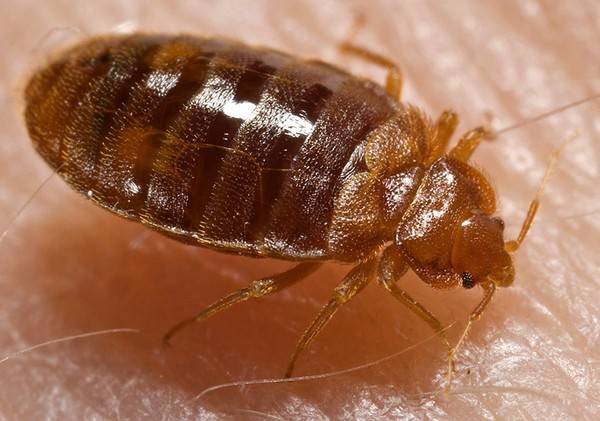Discover the nest of bacteria sleeping with your bed
Collection of hidden creatures on the bed, waiting for you to sleep passionately is disruptive.
>> Shape of bacteria clinging to human teeth
>> Infiltrating the world of bacteria inside the human body
After a tiring and exhausting day of work, the feeling of being able to enjoy the comfort of the familiar bed is really the best thing in the world.
But did you know, bed is not merely your paradise. In fact, there are many species of creatures that are sleeping with you every day. More frightening, when you are enjoying beautiful dreams, it is when they are raging.
1. Bed bugs
Bed bugs are small beetles of blood- sucking creatures (Hematophagy), belonging to a half-hard wing, they are flat and secreted. They specialize in bed slots, blankets, reflective chairs.

The food of bed bugs is human blood. When you are 'getting drunk', they will wake up and try to suck your blood. Even bed bugs can carry out blood sucking up to 500 times per night. Their vitality is also remarkable when they can still survive for three months without sucking blood.

Looking at this picture, do you dare to go to sleep?
Most bed bug bites are only itchy, uncomfortable but don't look down. In 2009, a man suffered from severe iron deficiency due to excessive blood-sucking bugs.
Despite the low risk, this species has the ability to transmit Trypanosoma cruzi parasite causing Chagas disease, a disease that leads to very dangerous heart inflammation .
2. Dust mites
Did you know, on your bed can hold up to 100,000 - 10 million dust mites with super small sizes. This is a creature that exists by eating human dead skin.

At first glance, they seem to be useful species, but they are not. Dust mites have a very 'unsanitary' habit, that is to go " universe" up to 20 times a day to bed. Therefore, inhaling their feces can cause asthma in humans.

Please introduce the scary "squeaky" army in bed
But don't worry too much, you can get rid of this species by regularly cleaning, keeping your room clean.
3. Clasdosporium mold
Clasdosporium is a mildew or green-brown mold that grows very strongly in wet environments. According to health experts, the beds in a humid and less cleaned house are paradises for this mold.

Inhalation of spores of Clasdosporium can cause pneumonia and asthma. In addition, infection with Clasdosporium can also lead to nail fungus, causing your skin to be damaged and causing chapped nails.
4. Head lice
If you do not clean the bed, the risk of becoming a "buddy" of the lice is very high. This is a small creature that specializes in sucking blood every night and life of about 30 days . Even in conditions that do not absorb blood, lice can survive for 2 consecutive days.

Lice bites are basically only itchy, but some severe cases can lead to typhus, scalp and hair infections.
5. Aspergillus Fumigatus
This type of fungus clings to bed sheets using synthetic materials.When we inhale fungal spores, they can invade the lungs and brain, causing Aspergillosis in people with a weak immune system .

Even if you are a healthy person, do not underestimate this fungus. In 2013, an American rugby player almost died due to the fungus growing in the brain.
6. Fire ants

Fire ants are species that can eat everything from insects to human flesh.When bitten by ants, their venom will make you feel extremely painful . In severe cases, some victims will experience anaphylactic reactions, even airway obstruction.
 Consequences caused by fire ants bite
Consequences caused by fire ants bite
Currently, in some states of the United States, fire ant colonies have invaded everywhere and even turned people's beds into their own territories.
7. E.coli bacteria
You may not believe it but scientists have proven that some dangerous strains of E.coli bacteria can be found in your beloved bed pillow.

E. Coli stands for Escherichia Coli, a bacterium belonging to the Enterobacteriaceae family.
If these E. coli infections are infected, the patient will experience symptoms such as fever and flu . Later, when E.coli invades organs like the brain and kidneys, they destroy these organs and cause the patient to die.
8. MRSA virus
MRSA (Methicillin-resistant Staphylococcus aureus) is found in pillows and they can penetrate into the human body through cuts or scratches on the skin.

The virus that infects humans will cause blood poisoning and body weakness. Worse, MRSA is very resistant to antibiotics. It is estimated that 20-50% of patients with MRSA infection are not able to treat with current drugs.
- Interesting findings about chimp's sleeping place
- How to use bird's nest is healthy
- Air nest dryer helps farmers save hundreds of millions of dong / year
- How to recognize real bird's nest water
- Discover the nest of 2 extinct shark species
- The nest nest knows how to plant fruit trees to make a nest
- Detecting super bird's nest
- Auction of dinosaur nest
- Haunting behind the whimsical white swan nest
- Starling birds grab enemies' beaks from the nest
- The giant ants 'wonder is likened to' Great Wall
- Risk of infection with H5N1 bird flu from bird nest
 Why do potatoes have eyes?
Why do potatoes have eyes? 'Tragedy' the world's largest carnivorous life: Death becomes ... public toilet
'Tragedy' the world's largest carnivorous life: Death becomes ... public toilet Tomatoes were once considered 'poisonous' for 200 years
Tomatoes were once considered 'poisonous' for 200 years Detecting microscopic parasites on human face
Detecting microscopic parasites on human face